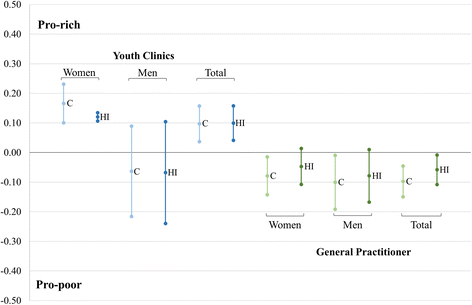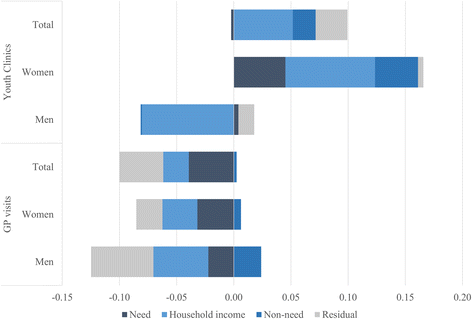Equitable health services for the young? A decomposition of income-related inequalities in young adults' utilization of health care in Northern Sweden
- PMID: 28100232
- PMCID: PMC5241958
- DOI: 10.1186/s12939-017-0520-3
Equitable health services for the young? A decomposition of income-related inequalities in young adults' utilization of health care in Northern Sweden
Abstract
Background: Despite the goal of the Swedish health system to offer health care according to the principle of horizontal equity, little is known about the equality in access to health care use among young people. To explore this issue, the present study aimed i) to assess horizontal inequity in health care utilization among young people in Northern Sweden; and ii) to explore the contribution of different factors to explain the observed inequalities.
Methods: Participants (N = 3016 youths aged 16-25 years) came from the "Health on Equal terms" survey conducted in 2014 in the four northernmost counties in Sweden. Concentration indices (C) and horizontal inequity indices (HI) were calculated to measure inequalities in the utilization of two health care services (general practitioners (GP) and youth clinics). The HI was calculated based on health care utilization and variables representing socioeconomic status (household income), health care needs factors and non-need factors affecting health care use. A decomposition analysis was carried out to explain the income-related inequalities.
Results: Results showed a significant positive income-related inequality for youth clinic utilization in women (C = 0.166) and total sample (C = 0.097), indicating that services were concentrated among the better-off. In contrast, general practitioner visits showed inequality pointing toward a higher utilization among less affluent individuals; significant in women (C = -0.079), men (C = -0.101) and pooled sample (C = -0.097). After taking health care needs into consideration, the utilization of youth clinics remained significantly pro-rich in women (HI = 0.121) and total sample (HI = 0.099); and consistently pro-poor for the GP visits in the pooled sample (HI = -0.058). The decomposition analyses suggest that socioeconomic inequalities explain a considerable portion of the pro-rich utilization of youth clinics services among young women. The corresponding analyses for GP visits showed that need factors and socioeconomic conditions accounted for the pro-poor concentration of GP visits.
Conclusion: The distribution of GP visits among young people in Northern Sweden slightly favored the low-income group, and thus seems to meet the premises of horizontal equity. In contrast, the findings suggest substantial pro-rich horizontal inequity in the utilization of youth clinics among young women, which are largely rooted in socioeconomic inequalities.
Keywords: Decomposition analysis; Health Inequality; Health care utilization; Horizontal inequity index; Sweden; Young adults.
Figures
Similar articles
-
Health care on equal terms? Assessing horizontal equity in health care use in Northern Sweden.Eur J Public Health. 2017 Aug 1;27(4):637-643. doi: 10.1093/eurpub/ckx031. Eur J Public Health. 2017. PMID: 28340208
-
Explaining inequalities in Health Care Utilization among Turkish adults: Findings from Health Survey 2008.Health Policy. 2016 Jan;120(1):100-10. doi: 10.1016/j.healthpol.2015.10.003. Epub 2015 Nov 10. Health Policy. 2016. PMID: 26563631
-
Is there equity in oral healthcare utilization: experience after achieving Universal Coverage.Community Dent Oral Epidemiol. 2009 Feb;37(1):85-96. doi: 10.1111/j.1600-0528.2008.00449.x. Community Dent Oral Epidemiol. 2009. PMID: 19191821
-
The equity impact of a universal child health promotion programme.J Epidemiol Community Health. 2020 Jun;74(7):605-611. doi: 10.1136/jech-2019-213503. Epub 2020 Apr 17. J Epidemiol Community Health. 2020. PMID: 32303594 Free PMC article. Review.
-
[Utilization of health care services in Brazil: gender, family characteristics, and social status].Rev Panam Salud Publica. 2002 May-Jun;11(5-6):365-73. doi: 10.1590/s1020-49892002000500011. Rev Panam Salud Publica. 2002. PMID: 12162833 Review. Portuguese.
Cited by
-
Assessing the income-related inequality in obesity among the elderly in China: A decomposition analysis.Front Public Health. 2022 Sep 9;10:918630. doi: 10.3389/fpubh.2022.918630. eCollection 2022. Front Public Health. 2022. PMID: 36159301 Free PMC article.
-
Unsafe and unequal: a decomposition analysis of income inequalities in fear of crime in northern Sweden.Int J Equity Health. 2018 Aug 1;17(1):110. doi: 10.1186/s12939-018-0823-z. Int J Equity Health. 2018. PMID: 30068322 Free PMC article.
-
Trends in the utilization of youth primary healthcare services and psychological distress.BMC Health Serv Res. 2021 Feb 3;21(1):115. doi: 10.1186/s12913-021-06124-w. BMC Health Serv Res. 2021. PMID: 33536017 Free PMC article.
-
Inequality in outpatient resource utilization among older adults during the 2007-2008 financial crisis: findings from Taiwan.BMC Health Serv Res. 2019 Sep 2;19(1):621. doi: 10.1186/s12913-019-4466-6. BMC Health Serv Res. 2019. PMID: 31477104 Free PMC article.
-
Assessing the youth-friendliness of youth clinics in northern Sweden: a survey analyzing the perspective of the youth.BMC Health Serv Res. 2020 Apr 23;20(1):346. doi: 10.1186/s12913-020-05188-4. BMC Health Serv Res. 2020. PMID: 32326967 Free PMC article.
References
-
- Riksdag S. Sveriges Riksdag. SFS 1982:763. 2 § Hälso-och sjukvårdslag. In: Socialdepartementet, editor. SFS 1982:763 2 §. 1982.
-
- Wagstaff A, Van Doorslaer E. Measuring and testing for inequity in the delivery of health care. J Hum Resour. 2000;35:716–33. doi: 10.2307/146369. - DOI
Publication types
MeSH terms
LinkOut - more resources
Full Text Sources
Other Literature Sources
Medical



